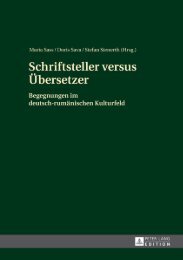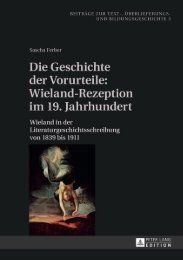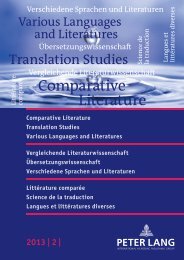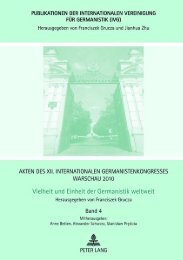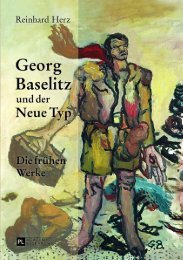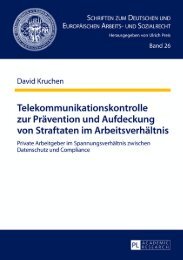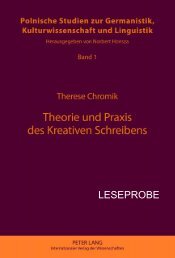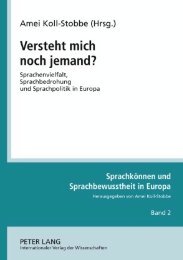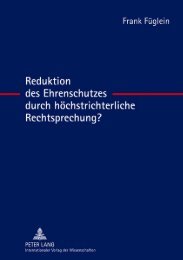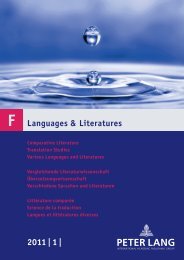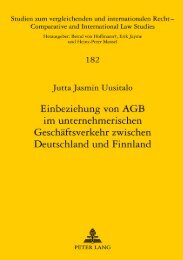Extract (PDF) - Peter Lang
Extract (PDF) - Peter Lang
Extract (PDF) - Peter Lang
You also want an ePaper? Increase the reach of your titles
YUMPU automatically turns print PDFs into web optimized ePapers that Google loves.
8 Fernanda Peñaloza<br />
this period are the focus of Patience A. Schell’s essay, which analyses the<br />
relationship between Robert FitzRoy and Charles Darwin, by looking<br />
at how perceptions of place are mediated by notions of masculinity and<br />
friendship.14 Schell examines the Beagle’s enterprise by identifying the role<br />
homosocial friendship played in FitzRoy’s and Darwin’s experience of travel<br />
and exploration. Nineteenth-century representations of Patagonia are also<br />
examined by Fiona J. Mackintosh, who problematises notions of genre and<br />
gender by highlighting Lady Florence Dixie’s intricate engagement with<br />
imperialistic and masculine discourses. Mackintosh traces these configurations<br />
of gender, power and discourse in three texts written by Dixie: her<br />
travelogue on Patagonia and two books for children set in the region.<br />
At a rhetorical level, most of the nineteenth-century travel to Patagonia<br />
had much to do with hopes of discovery, satisfying the public’s curiosity<br />
for the then ‘unknown’ parts of the world with their accounts. Through<br />
powerful discursive operations, the natives encountered by the travellers<br />
became confirmation of western civilisation’s ancestry.15 In the attempt to<br />
the Atlantic Coast to the Andes. Her experience across the Patagonian province of<br />
Chubut was first published in Welsh and it was entitled Dringo’r Andes. Casnewyddar-Wysg:<br />
Southall & Co., 1907. Morgan’s account has been printed and translated into<br />
Spanish as Hacia los Andes. Trans. Irma Hughes de Jones. Rawson: El Regional, 1982.<br />
Eluned Morgan’s father was one of the first settlers to arrive in 1865 to the province<br />
of Chubut. She was born on board a Welsh ship while her parents were going back<br />
to Patagonia after staying for some time in England in 1870. For more details on<br />
Morgan’s life see Virgina Haurie, Mujeres en Tierra de Hombres. Historias reales de<br />
la Patagonia Invisible. Buenos Aires: Editorial Sudamericana, 1998. 883–884. Apart<br />
from Morgan’s journal, there are two female-authored articles about the region; these<br />
are “The Hassler Glacier in the Straits of Magellan,” Atlantic Monthly 30 (October<br />
1872): 72–478 and “In the Straits of Magellan,” Atlantic Monthly 31 ( January 1873):<br />
89–95. Both were written by Elizabeth Cary Agassiz, who was born in Boston in<br />
1822. She wrote those articles while accompying her husband, the Swiss naturalist<br />
Louis Agassiz, on scientific expeditions.<br />
14 This is one of the most tense and significant relationships of British history; therefore,<br />
it is not surprising that a recent novel has this subject as central to its plot. See<br />
Harry Thompson, This Thing of Darkness. London: Headline Review, 2005.<br />
15 By the time European travellers were undertaking their journeys, and the Chilean<br />
and Argentine colonising projects were being carried out, there were different<br />
groups of indigenous peoples in the Patagonian region. There are many conflicting



